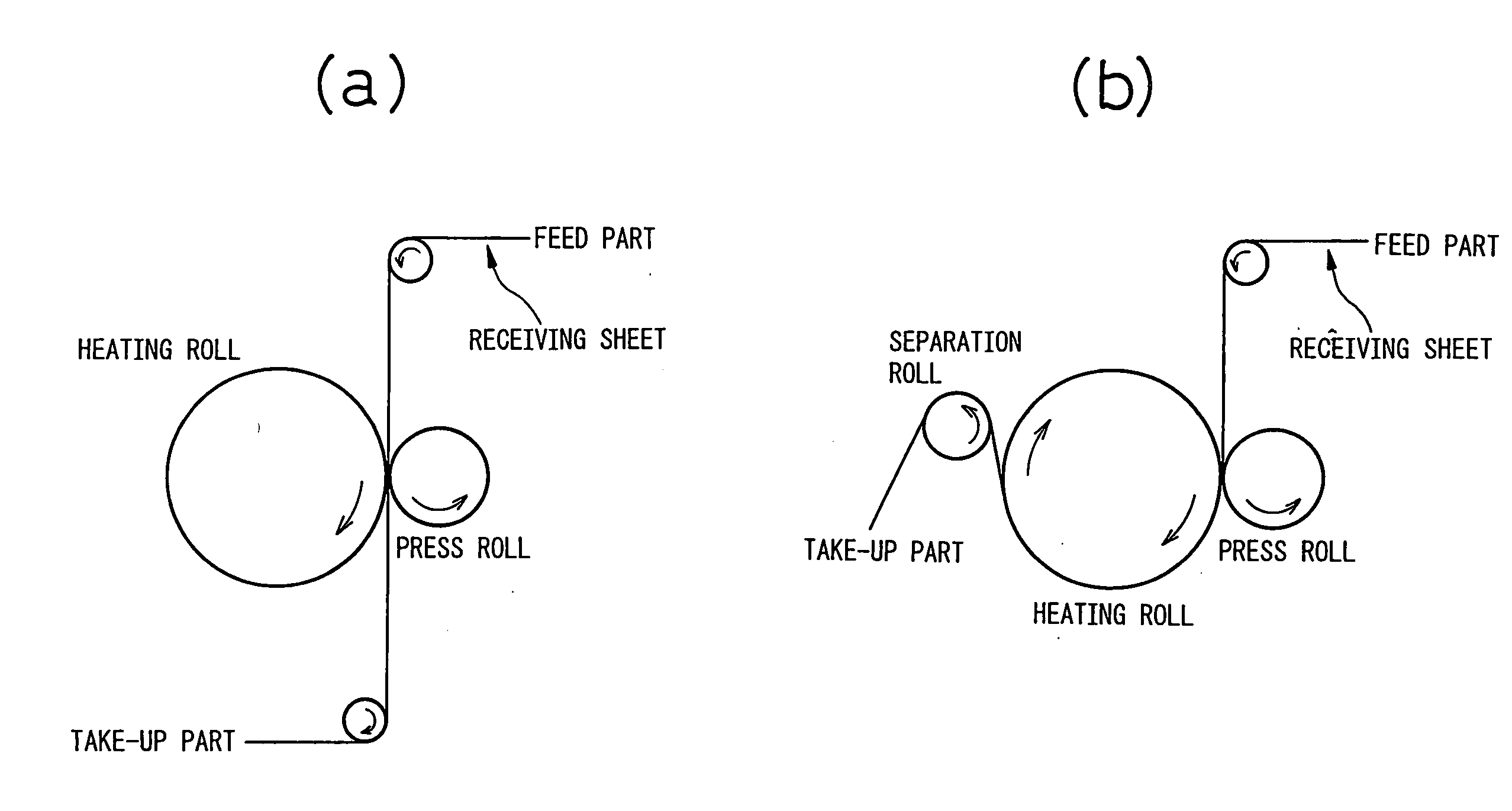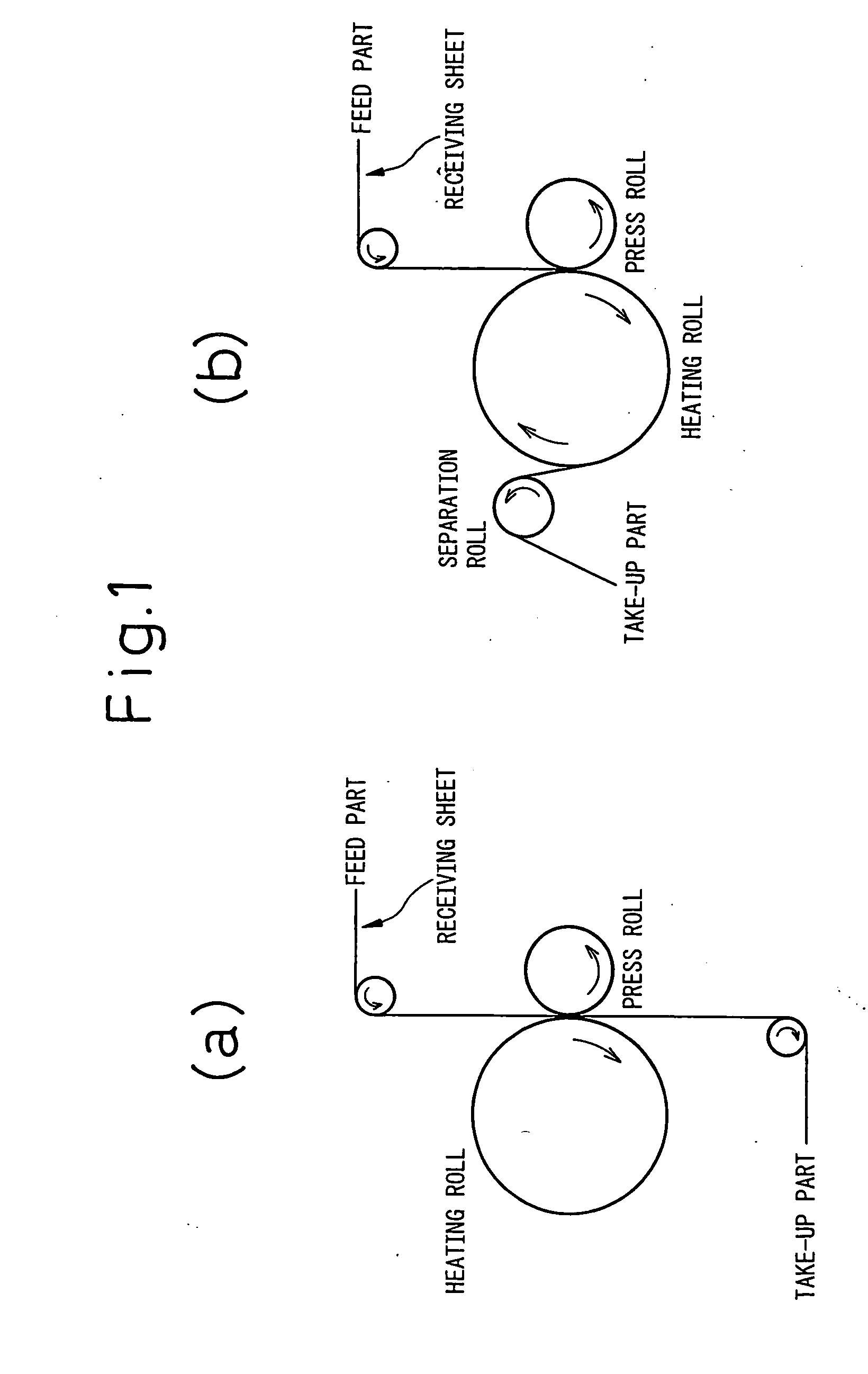Thermal Transfer Receiving Sheet, Production Method Thereof and Image Forming Method Using the Sheet
a technology of thermal head and receiving sheet, which is applied in the direction of thermography, duplicating/marking methods, coatings, etc., can solve the problems of reduced heat value of heating device such as thermal head, and reduced printing pressure by thermal head. , to achieve the effect of high image quality, low cost and excellent quality
- Summary
- Abstract
- Description
- Claims
- Application Information
AI Technical Summary
Benefits of technology
Problems solved by technology
Method used
Image
Examples
example 1
Formation of Back Surface Layer
[0142]Using a 150 μm-thick art paper (OK Kinfuji N, trade name, produced by Oji Paper Co., Ltd., 174.4 g / m2) as the sheet-like support, Back Surface Layer Coating Solution 1 having the following composition was coated on one surface thereof to have a dry coated amount in terms of solid content of 3 g / m2, and dried to form a back surface layer.
Back Surface Layer Coating Solution 1Polyvinyl acetal resin (ESLEC KX-1,40 partsproduced by Sekisui Chemical Co., Ltd.)Polyacrylic acid ester resin (JURYMER20 partsAT613, trade name, produced by NihonJunyaku Co., Ltd.)Nylon resin particles (MW330, trade10 partsname, produced by Shinto Toryo Co.,Ltd.)Zinc stearate (Z-7-30, trade name,10 partsproduced by Chukyo Yushi Co., Ltd.)Cationic electrically conducting resin20 parts(CHEMISTAT 9800, trade name, producedby Sanyo Chemical Industries Co., Ltd.)A 2 / 3 (by mass) mixed solution of400 parts water / isopropyl alcohol
[Formation of Intermediate Layer]
[0143]On the sheet-lik...
example 2
[0146]A receiving sheet was prepared and the receiving sheet after printing was subjected to a pressure treatment in the same manner as in Example 1 except that in the formation of the intermediate layer, Intermediate Layer Coating Solution 2 having the following composition was coated to have a dry thickness of 25 μm and dried to form the intermediate layer.
Intermediate Layer Coating Solution 2Copolymer-based prefoamed hollow35 partsparticles mainly comprisingacrylonitrile and acrylic acid ester(hollow percentage by volume: 79%,average particle diameter: 3.6 μm,maximum particle diameter: 19 μm)Polyvinyl alcohol (PVA205, trade name,15 partsproduced by Kuraray Co., Ltd.)Styrene-butadiene latex (PT1004, trade50 partsname, produced by Nippon ZEONCorporation)Water200 parts
example 3
[0147]A receiving sheet was prepared and the receiving sheet after printing was subjected to a pressure treatment in the same manner as in Example 1 except that in the formation of the intermediate layer, Intermediate Layer Coating Solution 3 having the following composition was coated to have a dry thickness of 40 μm and dried to form the intermediate layer.
Intermediate Layer Coating Solution 3Copolymer-based prefoamed hollow55 partsparticles mainly comprisingacrylonitrile and acrylic acid ester(hollow percentage by volume: 79%,average particle diameter: 3.6 μm,maximum particle diameter: 19 μm)Polyvinyl alcohol (PVA205, trade name,15 partsproduced by Kuraray Co., Ltd.)Styrene-butadiene latex (PT1004, trade30 partsname, produced by Nippon ZEONCorporation)Water200 parts
PUM
| Property | Measurement | Unit |
|---|---|---|
| Length | aaaaa | aaaaa |
| Length | aaaaa | aaaaa |
| Fraction | aaaaa | aaaaa |
Abstract
Description
Claims
Application Information
 Login to View More
Login to View More - R&D
- Intellectual Property
- Life Sciences
- Materials
- Tech Scout
- Unparalleled Data Quality
- Higher Quality Content
- 60% Fewer Hallucinations
Browse by: Latest US Patents, China's latest patents, Technical Efficacy Thesaurus, Application Domain, Technology Topic, Popular Technical Reports.
© 2025 PatSnap. All rights reserved.Legal|Privacy policy|Modern Slavery Act Transparency Statement|Sitemap|About US| Contact US: help@patsnap.com


